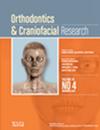Biomechanical effects of clear aligner with different shape design at extraction space area during anterior teeth retraction
Abstract
Objective
This study aimed to investigate the biomechanical effects of clear aligner (CA) with different shape designs at extraction space (CAES) area during space closing.
Materials and Methods
A finite-element method (FEM) model of mandibular dentition, periodontal ligaments, attachments, and corresponding CA was established. The connecting rod design of CAES was modelled for the control group. Eight test groups with different heights of CAES from −4 mm to +4 mm were designed. Tooth displacement tendencies were calculated. The maximum principal stress in PDLs, teeth, and CAs was analysed. Both global coordinate system and local coordinate system were also used to evaluate individual tooth movements.
Results
Across all groups, stresses concentrated on the lingual outer surface of CAESs. For the lowered CAES groups, both the stress value and the stress distribution area at CAESs were increased. The lowered CAES groups showed reduced movement in anterior teeth and less tipping tendency of the canines.
Conclusion
The shape of CAES has a biomechanical impact on anterior teeth movement and should be considered in aligner design. The results suggest that increasing the height of CAES can enhance anterior teeth retraction, while lowered CAES may facilitate controlled root movement. Changes in the shape of CAES represent a potential direction for biomechanical improvement of clear aligner in extraction cases and are worth exploring.

 求助内容:
求助内容: 应助结果提醒方式:
应助结果提醒方式:


